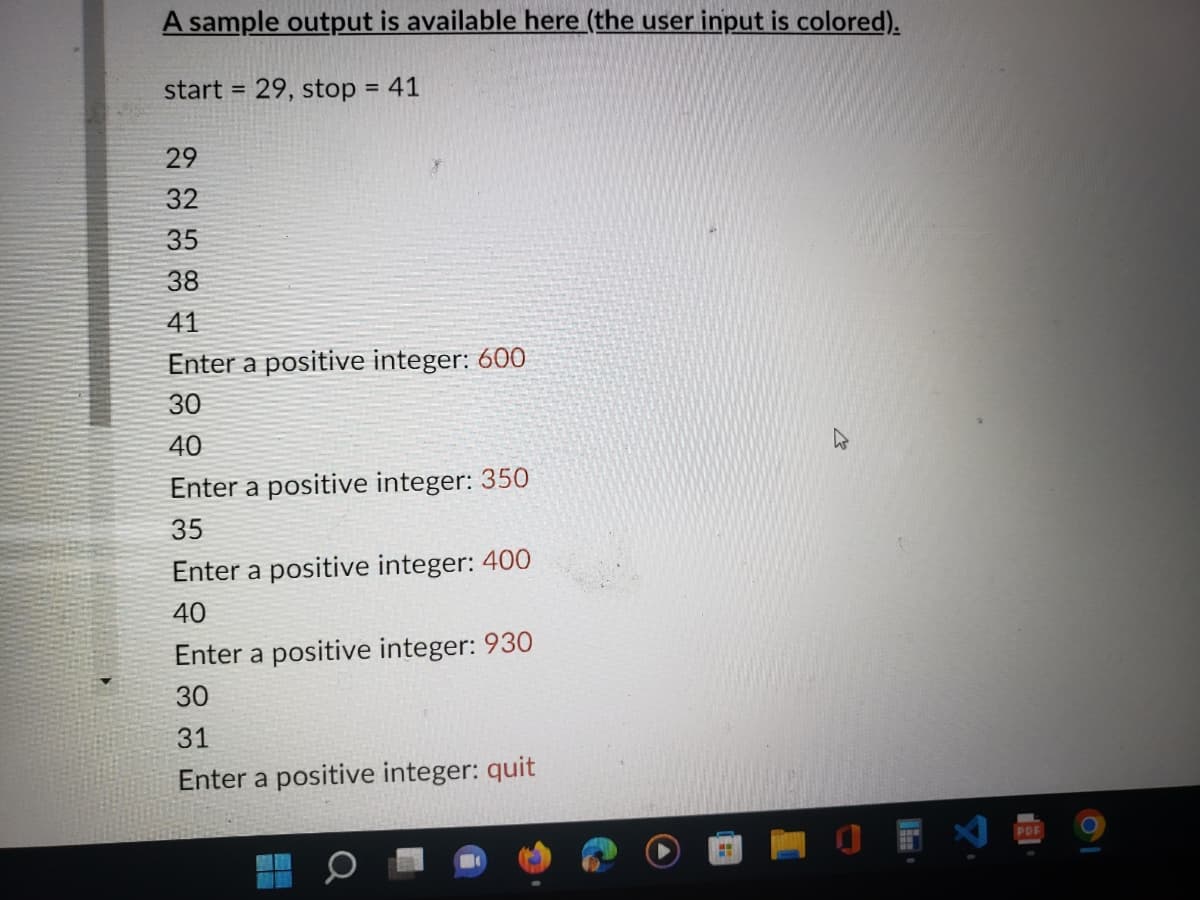Create a program named yourID_random.py student ID). Add the following functionality to your program. ● Use python's random module to pick two random integers between the range [10,100] (inclusive). Suppose, the minimum and the maximum of these two integers are start and stop, respectively. Print the values of start and stop, in this order, to the screen. Hint: use built-in functions max() and min(). . Write a precondition, event-controlled loop (i.e., a while loop), (replace your/D with your Carleton ● that prints all numbers returned by range(start, stop, 3) to the terminal. Ask the user repeatedly for a positive integer x, (input validation is not necessary), until the user enters "quit". If x falls outside this range [start, stop] (inclusive), print all those numbers that are in [start, stop], and that divide x. That is, if x gets divided by those numbers, there will be no remainder. Upload yourID_random.py file using the option available at the end of this question. You do not need to zip this file. Comments are not necessary. A sample output is available here (the user input is colored).
Create a program named yourID_random.py student ID). Add the following functionality to your program. ● Use python's random module to pick two random integers between the range [10,100] (inclusive). Suppose, the minimum and the maximum of these two integers are start and stop, respectively. Print the values of start and stop, in this order, to the screen. Hint: use built-in functions max() and min(). . Write a precondition, event-controlled loop (i.e., a while loop), (replace your/D with your Carleton ● that prints all numbers returned by range(start, stop, 3) to the terminal. Ask the user repeatedly for a positive integer x, (input validation is not necessary), until the user enters "quit". If x falls outside this range [start, stop] (inclusive), print all those numbers that are in [start, stop], and that divide x. That is, if x gets divided by those numbers, there will be no remainder. Upload yourID_random.py file using the option available at the end of this question. You do not need to zip this file. Comments are not necessary. A sample output is available here (the user input is colored).
Programming Logic & Design Comprehensive
9th Edition
ISBN:9781337669405
Author:FARRELL
Publisher:FARRELL
Chapter11: More Object-oriented Programming Concepts
Section: Chapter Questions
Problem 2GZ
Related questions
Question

Transcribed Image Text:A sample output is available here (the user input is colored).
= 29, stop = 41
start =
29
32
35
38
41
Enter a positive integer: 600
30
40
Enter a positive integer: 350
35
Enter a positive integer: 400
40
Enter a positive integer: 930
30
31
Enter a positive integer: quit
HH
PDF
![Create a program named yourID_random.py
student ID). Add the following functionality to your program.
●
●
●
(replace your/D with your Carleton
Use python's random module to pick two random integers between the range
[10,100] (inclusive). Suppose, the minimum and the maximum of these two
integers are start and stop, respectively. Print the values of start and stop, in
this order, to the screen. Hint: use built-in functions max() and min().
Write a precondition, event-controlled loop (i.e., a while loop),
that prints all numbers returned by range(start, stop, 3) to the terminal.
Ask the user repeatedly for a positive integer x, (input validation is not
necessary), until the user enters "quit". If x falls outside this range [start, stop]
(inclusive), print all those numbers that are in [start, stop], and that divide x.
That is, if x gets divided by those numbers, there will be no remainder.
Upload yourID_random.py file using the option available at the end of this question.
You do not need to zip this file. Comments are not necessary.
A sample output is available here (the user input is colored).
HEM
MAY
TX
PDF
O](/v2/_next/image?url=https%3A%2F%2Fcontent.bartleby.com%2Fqna-images%2Fquestion%2F9e2b96c1-3468-437a-a294-6f714c454d95%2F465815ca-1f46-4250-abc3-96f3a6e785d8%2F1uvlesm_processed.jpeg&w=3840&q=75)
Transcribed Image Text:Create a program named yourID_random.py
student ID). Add the following functionality to your program.
●
●
●
(replace your/D with your Carleton
Use python's random module to pick two random integers between the range
[10,100] (inclusive). Suppose, the minimum and the maximum of these two
integers are start and stop, respectively. Print the values of start and stop, in
this order, to the screen. Hint: use built-in functions max() and min().
Write a precondition, event-controlled loop (i.e., a while loop),
that prints all numbers returned by range(start, stop, 3) to the terminal.
Ask the user repeatedly for a positive integer x, (input validation is not
necessary), until the user enters "quit". If x falls outside this range [start, stop]
(inclusive), print all those numbers that are in [start, stop], and that divide x.
That is, if x gets divided by those numbers, there will be no remainder.
Upload yourID_random.py file using the option available at the end of this question.
You do not need to zip this file. Comments are not necessary.
A sample output is available here (the user input is colored).
HEM
MAY
TX
PDF
O
Expert Solution
This question has been solved!
Explore an expertly crafted, step-by-step solution for a thorough understanding of key concepts.
Step by step
Solved in 3 steps with 1 images

Knowledge Booster
Learn more about
Need a deep-dive on the concept behind this application? Look no further. Learn more about this topic, computer-science and related others by exploring similar questions and additional content below.Recommended textbooks for you

Programming Logic & Design Comprehensive
Computer Science
ISBN:
9781337669405
Author:
FARRELL
Publisher:
Cengage

EBK JAVA PROGRAMMING
Computer Science
ISBN:
9781337671385
Author:
FARRELL
Publisher:
CENGAGE LEARNING - CONSIGNMENT

Microsoft Visual C#
Computer Science
ISBN:
9781337102100
Author:
Joyce, Farrell.
Publisher:
Cengage Learning,

Programming Logic & Design Comprehensive
Computer Science
ISBN:
9781337669405
Author:
FARRELL
Publisher:
Cengage

EBK JAVA PROGRAMMING
Computer Science
ISBN:
9781337671385
Author:
FARRELL
Publisher:
CENGAGE LEARNING - CONSIGNMENT

Microsoft Visual C#
Computer Science
ISBN:
9781337102100
Author:
Joyce, Farrell.
Publisher:
Cengage Learning,